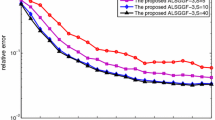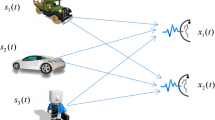Abstract
This paper proposes a class of new algorithms based on first- and second-order statistics for independent source extraction of circular signals in underdetermined complex-valued mixture. The complex-valued mixing matrix is estimated by two extremely cost-effective novel methods based on the conditional mean of the mixtures which require some prior knowledge of the positive support of the real and/or imaginary parts of the sources. And the sources are recovered by combining the conventional minimum mean-squared error-based beamforming approach with the acquired prior knowledge. Based on how much prior knowledge is got, we propose several new algorithms. The complexity analysis about the proposed algorithms suggests that the algorithms which employ more prior knowledge have higher complexity, but their computational cost is significantly low. Two examples are provided for showing the possible applications of these proposed algorithms. Simulation results validate the effectiveness and reliability of all presented methods.















Similar content being viewed by others
References
L. Albera, A. Ferreol, P. Comon et al., Blind identification of overcomplete mixtures of sources (BIOME). Linear Algebra Appl. 391, 1–30 (2004)
P. Bofill, M. Zibulevsky, Underdetermined blind source separation using sparse representations. Signal Process. 81(11), 2353–2362 (2001)
R.M. Clemente, S.H. Mellado, J.L.C. Olivares, Fast independent component analysis using a new property, in International Work Conference on Artificial Neural Networks (IWANN) (2011), pp. 477–483
P. Comon, C. Jutten et al., Handbook of Blind Source Separation: Independent Component Analysis and Applications (Academic Press, New York, 2010)
S.H. Hsu, T.R. Mullen, T.P. Jung et al., Real-time adaptive EEG source separation using online recursive independent component analysis. IEEE Trans. Neural Syst. Rehabil. Eng. 24(3), 309–319 (2016)
A. Karfoul, L. Albera, D.L. Lathauwer, Iterative methods for the canonical decomposition of multi-way arrays: application to blind underdetermined mixture identification. Signal Process. 91(8), 1789–1802 (2011)
S. Kim, C.D. Yoo, Underdetermined blind source separation based on subspace representation. IEEE Trans. Signal Process. 57(7), 2604–2614 (2009)
Z. Koldovský, P. Tichavský, A.H. Phan et al., A two-stage MMSE beamformer for underdetermined signal separation. IEEE Signal Process. Lett. 20(12), 1227–1230 (2013)
D. Kumar, C.S. Rai, S. Kumar, Analysis of unsupervised learning techniques for face recognition. Int. J. Imaging Syst. Technol. 20(3), 261–267 (2010)
D.L. Lathauwer, J. Castaing, J.F. Cardoso, Fourth-order cumulant based blind identification of underdetermined mixtures. IEEE Trans. Signal Process. 55(6), 2965–2973 (2007)
D.L. Lathauwer, J. Castaing, Blind identification of underdetermined mixtures by simultaneous matrix diagonalization. IEEE Trans. Signal Process. 56(3), 1096–1105 (2008)
H. Lin, T. Thaiupathump, S.A. Kassam, Blind separation of complex I/Q independent sources with phase recovery. IEEE Signal Process. Lett. 12(5), 419–422 (2005)
F. Petre, M. Engels, A. Bourdoux et al., Extended MMSE receiver for multiuser interference rejection in multipath DS-CDMA channels, in Vehicular Technology Conference, vol. 3 (1999), pp. 1840–1844
R. Phlypo, V. Zarzoso, I. Lemahieu, Source extraction by maximizing the variance in the conditional distribution tails. IEEE Trans. Signal Process. 58(1), 305–316 (2010)
G.K. Sang, D.Y. Chang, Underdetermined independent component analysis by data generation, in Independent Component Analysis and Blind Source Separation (ICA) (2004), pp. 445–452
P.F. Stenumgaard, On radiated emission limits for pulsed interference to protect modern digital wireless communication systems. IEEE Trans. Electromagn. Compat. 49(4), 931–936 (2007)
Q. Su, Y. Shen, Y. Wei et al., SSP-based UBI algorithms for uniform linear array. Circuits Syst. Signal Process. 36(10), 4077–4096 (2017)
Q. Su, Y. Wei, C. Deng et al., Fast extraction for skewed source signals using conditional expectation. J. Sens. 2018, 1–6 (2018)
P. Tichavský, Z. Koldovský, Weight adjusted tensor method for blind separation of underdetermined mixtures of nonstationary sources. IEEE Trans. Signal Process. 59(3), 1037–1047 (2011)
B. Xerri, B. Borloz, An iterative method using conditional second-order statistics applied to the blind source separation problem. IEEE Trans. Signal Process. 52(2), 313–328 (2004)
P.C. Xu, Y.H. Shen, H. Li et al., Independent component analysis of complex valued signals based on first-order statistics. Radioengineering 22(4), 1194–1201 (2013)
L. Yang, H. Zhang, Y. Cai, A low-complexity PARAFAC decomposition for underdetermined blind system identification with complex mixtures. Circuits Syst. Signal Process. 37, 4842–4860 (2018)
Z. Yang, Y. Xiang, Y. Rong et al., A convex geometry-based blind source separation method for separating nonnegative sources. IEEE Trans. Neural Netw. 26(8), 1635–1644 (2015)
W. Yu, R. Lui, Dual methods for nonconvex spectrum optimization of multicarrier systems. IEEE Trans. Commun. 54(7), 1310–1322 (2006)
V. Zarzoso, R.M. Clemente, S.H. Mellado, Independent component analysis based on first-order statistics. Signal Process. 92(8), 1779–1784 (2012)
H. Zhu, S. Zhang, H. Zhao, Single-channel source separation of multi-component radar signal with the same generalized period using ICA. Circuits Syst. Signal Process. 35(1), 353–363 (2016)
Acknowledgements
This work was supported by the National Natural Science Foundation of China under Grant Nos. 61172061 and 61201242 and the Natural Science Foundation of Jiang Su Province in China under Grant No. BK2012057.
Author information
Authors and Affiliations
Corresponding author
Appendix: Derivation of Formula (9)
Appendix: Derivation of Formula (9)
We show the derivation from Eqs. (8) to (9). Note that Eq. (8) can be easily simplified in the real case, while it is more complicate for the complex case. We omit the t in following derivation for convenience and rewrite the object function as
The term \(E\{ {{\mathrm{Re}} ^2}\{ {s_j}\} + {{\mathrm{Im}} ^2}\{ {s_j}\} \} \) in Eq. (24) is irrelevant to \({\mathbf{w}}_j\), so we cut out this term in the object function. By employing \({\widehat{s}_j}(t) = {\mathbf{w}}_j^\mathrm{{H}}(t){\mathbf{x}}(t)\), \(E\{ {{\mathrm{Re}} ^2}\{ {{\hat{s}}_j}\} \} \) is computed by
where the superscript \({\left( \cdot \right) ^*}\) denotes the conjugate operator. Similarly, \(E\{ {{\mathrm{Im}} ^2}\{ {{\hat{s}}_j}\} \} \) is expressed as
Set \({\mathbf{D}} = E\{ {\mathrm{Re}} \{ {\mathbf{x}}\} {{\mathrm{Re}} ^\mathrm{{T}}}\{ {\mathbf{x}}\} \} + E\{ {\mathrm{Im}} \{ {\mathbf{x}}\} {{\mathrm{Im}} ^\mathrm{{T}}}\{ {\mathbf{x}}\} \} \)\({\mathbf{G}} = E\{ {\mathrm{Re}} \{ {\mathbf{x}}\} {{\mathrm{Im}} ^\mathrm{{T}}}\{ {\mathbf{x}}\} \} \). Stack up \({\mathbf{D}}\) and \({\mathbf{G}}\) into \({\mathbf{Q}} = \left( {\begin{array}{*{20}{c}} {\mathbf{D}}&{}\quad {\mathbf{0}}\\ {\mathbf{0}}&{}\quad {\mathbf{D}} \end{array}} \right) \) and \({\mathbf{U}} = \left( {\begin{array}{*{20}{c}} {\mathbf{0}}&{}\quad { -\, {\mathbf{G}}}\\ {\mathbf{G}}&{}\quad {\mathbf{0}} \end{array}} \right) \), respectively. The term \(E\{ {{\mathrm{Re}} ^2}\{ {{\hat{s}}_j}\} + {{\mathrm{Im}} ^2}\{ {{\hat{s}}_j}\} \} \) in Eq . (24) becomes
where \({\widetilde{\mathbf{w}}_j} = {[ {\begin{array}{*{20}{c}} {{\mathrm{Re}} \{ {\mathbf{w}}_j^\mathrm{{T}}\} }&\quad { -\, {\mathrm{Im}} \{ {\mathbf{w}}_j^\mathrm{{T}}\} } \end{array}} ]^\mathrm{{T}}}\). Since \({\mathbf{x}} = {\mathbf{As}} = \sum \nolimits _{i = 1}^N {{{\mathbf{a}}_i}{s_i}} \), it can be easily got that
Then, \(E\{ \mathrm{{Re}}\{ {s_j}\} \mathrm{{Re}}\{ {{\hat{s}}_j}\} \} \) is calculated to be
Similarly, \(E\{ {\mathrm{Im}} \{ {s_j}\} {\mathrm{Im}} \{ {{\hat{s}}_j}\} \} \) is obtained by
Thus, by combining Eqs. (29) and (30), the term \(E\{ {\mathrm{Re}} \{ {s_j}\} {\mathrm{Re}} \{ {{\hat{s}}_j}\} + {\mathrm{Im}} \{ {s_j}\} {\mathrm{Im}} \{ {{\hat{s}}_j}\} \} \) in Eq . (24) turns to be
where \({\widetilde{\mathbf{a}}_j} = {[ {\begin{array}{*{20}{c}} {{\mathrm{Re}} \{ {\mathbf{a}}_j^\mathrm{{T}}\} }&\quad { -\, {\mathrm{Im}} \{ {\mathbf{a}}_j^\mathrm{{T}}\} } \end{array}} ]^\mathrm{{T}}}\). Then, replacing the corresponding terms in Eq. (24) by the results in Eqs. (27) and (31), we achieve the final object function shown by \(2\widetilde{\mathbf{w}}_j^\mathrm{{T}}{\widetilde{\mathbf{a}}_j} - \widetilde{\mathbf{w}}_j^\mathrm{{T}}({\mathbf{Q}} + 2{\mathbf{U}}){\widetilde{\mathbf{w}}_j}\).
Additionally, \(\mathrm{{Re}}\{ {{\hat{s}}_j}\}\) is given by
where \(\widetilde{\mathbf{x}} = {[ {\begin{array}{*{20}{c}} {{\mathrm{Re}} \{ {{\mathbf{x}}^\mathrm{{T}}}\} }&\quad { -\, {\mathrm{Im}} \{ {{\mathbf{x}}^\mathrm{{T}}}\} } \end{array}}]^\mathrm{{T}}}\). So, the constraint in Eq. (8) becomes \(- \widetilde{\mathbf{w}}_j^\mathrm{{T}}\widetilde{\mathbf{x}} < 0\).
This completes the proof.
Rights and permissions
About this article
Cite this article
Su, Q., Wei, Y., Shen, Y. et al. Underdetermined Independent Component Analysis Based on First- and Second-Order Statistics. Circuits Syst Signal Process 38, 3107–3132 (2019). https://doi.org/10.1007/s00034-018-0997-z
Received:
Revised:
Accepted:
Published:
Issue Date:
DOI: https://doi.org/10.1007/s00034-018-0997-z




